Last week at CES Sony announced their latest action cam, the Sony FDR-X1000V, which is capable of shooting 4K video. They also updated their HDR-AS camera line with a new 200V version (HDR-AS200V). These came as a surprise to approximately nobody. The reason being Sony aligns to just as much clockwork as GoPro does when it comes to action cam releases. GoPro in September/October, and Sony at CES in January. Wham, bam, thank you ma’am.
4K Action Cam Introduction:
However, despite that predictability, Sony continues to really push the envelope on coolness that extends beyond just straight image quality. And to a certain degree they probably don’t get enough credit for it. But before we get there, let’s just briefly note the 4K aspects.
The FDR-X1000V supports 4K in the following frame rates:
30p: 3840×2160 (4K) 30p/25p
24p: 3840×2160 (4k) 24p
Now what’s somewhat interesting here is that unlike GoPro series neither the X1000V nor the AS200V support 2.7K video as a ‘middle ground’ for increasing frame-rates. The GoPro Hero4 Black for example can step down to 2.7K at a slew of frame rates upwards as high as 50fps. The Black also has a 1440p mode upwards of 80fps, and the GoPro Hero4 Silver can hit 2.7K at upwards of 30fps.
Meanwhile, the X1000V and 200V’s next steps are basically 1080p resolution, and they never go higher than the GoPro models within the 1080p range, where both companies top out at 120fps. It’s the lack of 1440p and 2.7K footage that’s odd on the Sony side.
Outside of the image quality updates, both the GPS-enabled FDR-X1000V and HDR-AS200V did receive exposure control, and new white balance & color temperature override mode, which from talking to the guys at the Sony CES booth is roughly in the same vein as the GoPro ProTune mode that allows a bit more control in post production in those areas. Both units also got wind noise reduction capabilities.
Finally, they also get the new highlight reel function I talk about a bit later in the post.
(Side note: I always enjoy talking to the guys that Sony brings to CES each year to staff the action cam portions of their booth – they actually know their products technically quite well. Something that the GoPro booth folks rarely manage to pull off. In general I find Best Buy folks know more about GoPro units than the GoPro staff at the booth do.)
Do note that at this point the battery life is still to be determined. This will definitely be a big ticket item because with 4K footage on the competitor GoPro Hero4 Black you’re basically looking at about 60 minutes of battery life (on a good day). Sony says they’ll release that information closer to release.
One other disappointing item is that Sony didn’t update the rather dated LCD screen on the side of the camera. There’s nothing wrong with a small monochrome LCD. GoPro has such a display, except GoPro’s is actually a very clean interface. The Sony is simply not; and clunky to navigate. Plus, the GoPro Hero4 Silver now has a full color touchscreen on the back for those that want it, whereas Sony has no such built-on offering aside from a separate wrist remote.
Multi Camera Control:
Now, while everyone is focusing on all the 4K stuff – it’s actually the multicam preview capabilities that’s really cool. Currently most cameras on the market allow you to control all the cameras at once through various remote systems. But what they don’t allow you to do is to concurrently preview all these action cams. This meant that you either had to manually connect to each one via individual WiFi networks and preview them one at a time, or, just hope for the best.
With an update planned for this spring, Sony will bring multi camera control to all their recent action cameras – anything that supports the WiFi Direct, which is pretty cool. Below you can see the cameras showing live as seen mounted around in the above photo. If you look around the vehicle you’ll see some of the action cams shooting the various shots below (including of me).
That will come to both iOS and Android apps as part of PlayMemories Mobile 5.2. It will be able to support up to five concurrent action cams with preview – inline with what their latest WiFi remote (RM-LVR2) can do.
For those that might be a little bit unsure of what all this means, this diagram helps to explain it a little bit. The most important part is that you’re concurrently both controlling and previewing the below four cameras at once. All other solutions out there today can only trigger the concurrent start/stop, not the concurrent preview.
It’s worth noting that Sony’s desktop software is very powerful when it comes to taking all of this footage from multiple cameras and then giving you multi-cam videos (for example, split screen). It’s an area that both GoPro and Garmin really lack in, especially since both of them have remotes to trigger such multi-cam operations. I’ve never understood why they bother to provide that capability in hardware yet lack the follow-through in software to put cool split-screen style videos together. Sony definitely delivers there. Plus you’ll get all the cool GPS overlay information too.
A Few Other Software and Hardware Notables:
Now in addition to the above, the X1000V and 200V will get a new highlight reel feature. They say this will automatically spit out a few-minute highlight reel from your day, using facial recognition and scene detection to determine what’s ‘important’. You’ll remember one or two Kickstarter projects recently that are also doing this for GoPro footage, but with the concurrent use of an Android phone.
In the case of Sony, they’re lucky in that both of these units contain GPS chipsets on them, so they can better analyze things like speed changes and likely GPS elevation as well. By focusing on shifts in those metrics they can reasonably predict ‘exciting’ things. Or at least, that’s the theory.
Moving towards hardware items, Sony has expanded their mounts with this release wave. This includes a new waterproof case for the X1000V (seen left above), along with a different dive door for better focusing (seen middle left above). Also, both a helmet mount (seen far right above), and then a board mount for surf and snowboards (seen middle/back above).
Next up we’ve got a sweet little mount for the DJI Phantom2. Note that it isn’t a gimbal mount however, which is kinda a bummer. So that means that it won’t quite be as smooth as video shot by gimbal mounts (like what’s available for the GoPro series).
Now, the only odd part is that nobody could seem to actually provide me the name of the 3rd party company producing above said mount. Not for lack of trying on their part, it was just the one area where a large lot of folks couldn’t seem to find the answer.
Finally, Sony was fairly proud of their image stabilization. They used the below test rig to demonstrate how it works. The bike handlebars constantly shake, and then they had two identical cameras – one with image stabilization enabled, and one with it disabled.
Here’s a short clip I shot of it in action. The left TV screen is with stabilization, and the right is without.

Pretty neat stuff. Anyone want to build one of those for me? Love it!
With that, I’m definitely going to be doing a full in-depth review of the FDR-X1000V once it hits sometime this spring. While I’ve used both previous generations, I think this will be the time I’ll transition into doing an in-depth review of the cams for the first time.
Thanks for reading!
Found this review useful? Support the site:
–Welcome to CES 2015 posts! Don’t forget to check out all my CES 2015 coverage, as well as a slew of updates that were only seen on Twitter. It was a crazy busy week!
—
Update: You can now order the latest Sony Action Cams via Clever Training. In doing so you not only help support the site, but also save yourself 10% and get free US shipping using coupon code DCR10BTF! There are basically four SKU’s, one for each camera and then a variant with or without the Live View remote/display wrist band:
Sony FDR-X1000V (with or without Live View bundle)
Sony HDR-AS200V (with or without Live View bundle)
As a reminder, the 1000V is the 4K capable cam, and the 200V is the smaller unit that’s not 4K capable. The Live View remote is identical no matter which camera you choose.
Thanks again for your support via Clever Training!


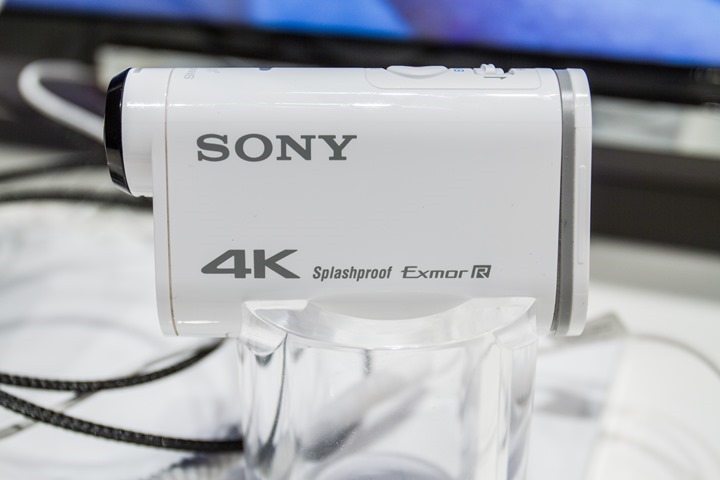

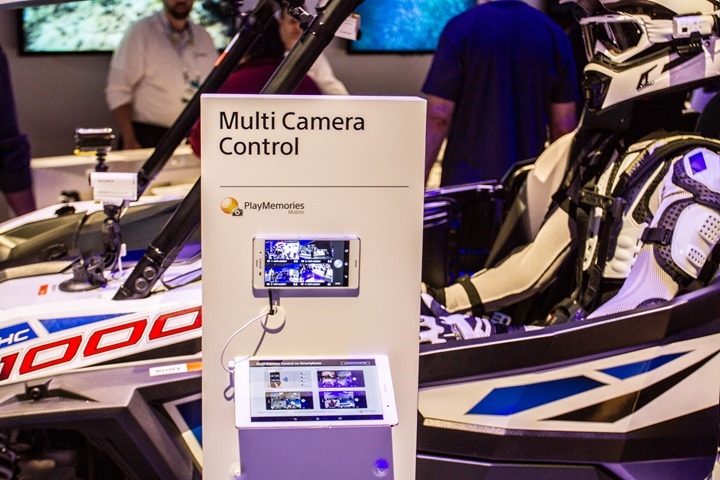
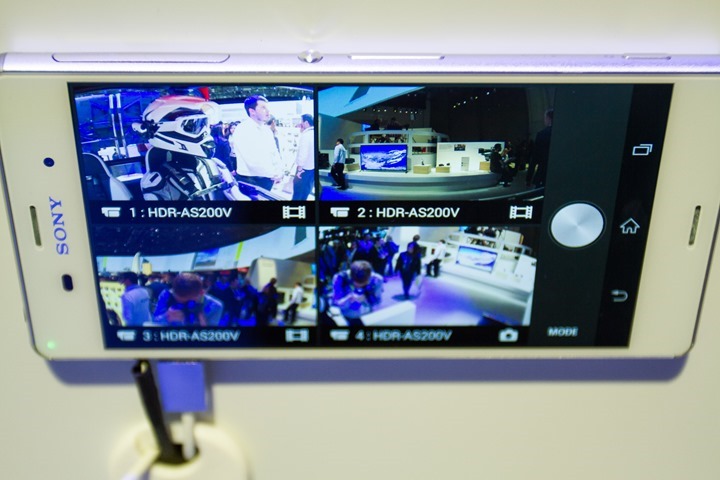
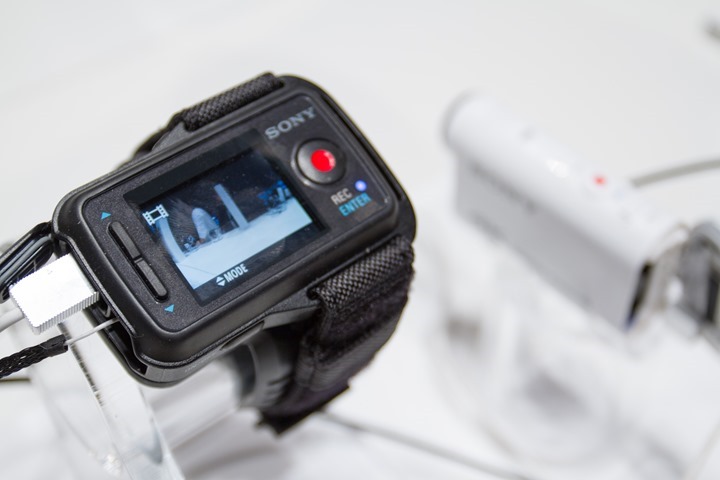
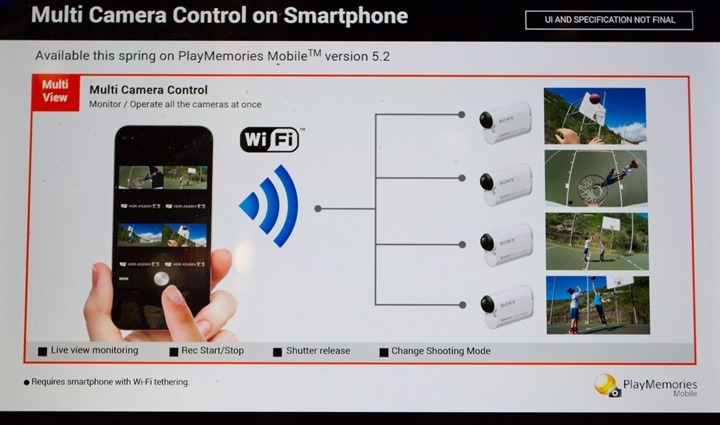
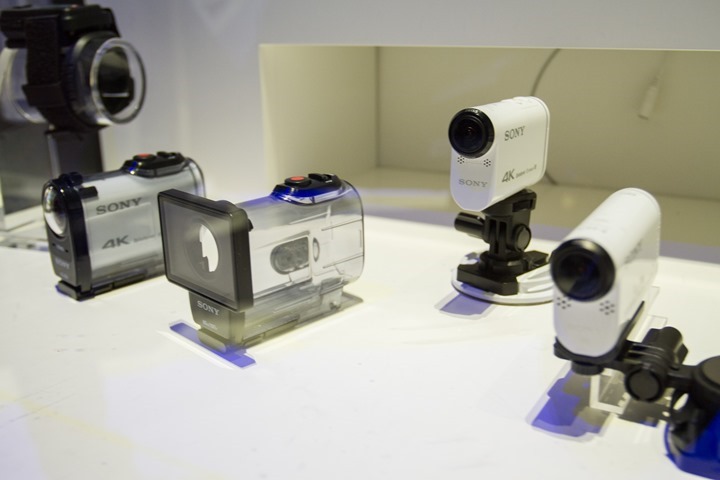

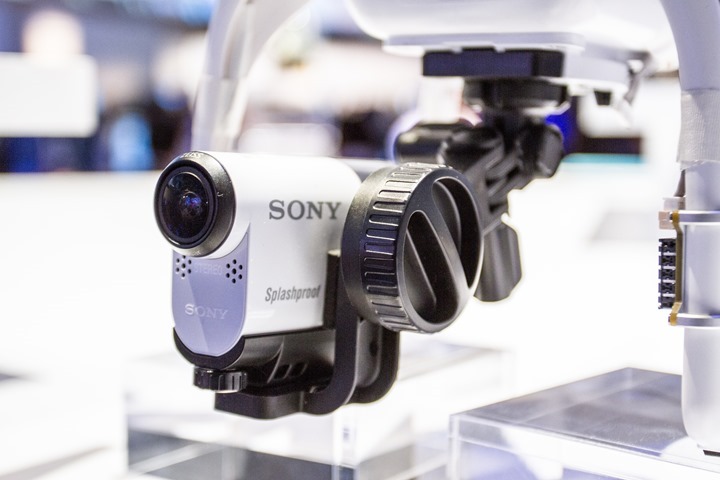






















Thanks for your first look!
It’s no good idea by Sony only offering FullHD and 4K! The 2.7K of Gopro is very usefull in postprocessing. These 2.7K are giving, for example, room for deshaking more than 50% in a frame!
Sony Action cams have the problem, that videos recorded with steadshot are a little bit washed, they lost their sharpness and rolling shutter becomes more visible. With 2.7K without Steadyshot, recorded with 60P you have in postprocessing a lot more screws to play with for better results!
It will be very interessting to see if the X1000V has improved their steadyshot video quality.
But why should`nt Sony offer a firmware update for delivering forgotten features? Hope dies last!
Of course you could do exactly what you are saying with 4K video and then transcoding it to 1080p. Unless you are working with an underpowered computer.
Usually – in GoPro at least, and almost certainly here – there’s a drop in bitrate that accompanies the higher res footage. It’s one of the ways they manage to pull off 4K with standard memory cards etc. What that means is that 4K won’t have the dynamic range or colour depth of 1080, and so from a post-processing point of view you’re losing a fair bit by recording at 4K and reducing resolution after. 2K or 2.7K are much better compromises.
Timmy, Sony usually doesn’t work this way. For instance they have two different encoding methods in their 1080P cameras and H.264 and XAVC S. GoPro only uses H.264 and its correspondingly lower bandwidth compared to XAVC S. On the specs of the 4K cameras they list two bitrates for XAVCS 50-60Mbps and 100Mbps. These will provide better fidelity that GoPro’s current 4K offerings. Just don’t go assuming everyone does it because GoPro does it.
In essence you actually gain editing 4K with Sony as the source as opposed to GoPro with 2.7K as the source.
Well I’d prefer filming at 2.7k with 60p than 4k with 30p or 1080 with 120p… the 2.7k middleground is exactly that, the perfect middle to be able to do slow-motion and still deshake in after processing
You appear to be trolling for GoPro…because most of what you said is not true: I own both systems X1000V and GoPro Hero4 and I assure any reader that the steadyshot does not ‘wash’ out the image….the image is superior in everyway to gopro…it has 5 or 6 stops more dynamic range with which to work in post and if your machine can do 3K but not 4K…get a new machine…4K and 5 and 6K are here to stay.
Not at all true withthe Sony X1000V….bit rate of over 100 Mbps….may have been true in the past but the technlogy is now upon us….far superior to the GoPro…not just broadcast quality footage but 4K broadcast footage and far superior to the 1080P when reduced to 1080 in post from the 4K footage….when you own one…you’ll know….
Ignoring which camera is better than the other quality-wise, I can’t see any logical explanation as to why Sony doesn’t have a 2.7K option. It’s frankly just stupid.
I’m often in a scenario where I’d love to shoot higher than 1080p but don’t want to deal with the processing times associated with 4K. As others noted, 2.7K offers that balance.
Thanks for the preview but I got confused by the “Meanwhile, the X1000V and 200V’s next steps are basically 1080p resolution” sentence as I thought the 200V was a 1080p camera and after looking it up it is, so there is no “next step” for it ;-)
Other items of note I found :
– the 200V is presumably the same size as the current AS100 (yes, link to sony.fr) so it should be able to use the excellent AKA-LU1 “camcorder” case.
– The X1000V is apparently larger (yes, link to sony.fr) so will lose that compatibility and the record button now being conveniently placed on top it wouldn’t work anyway.
– There is an (optional?) buffer memory to start recording a few seconds before you actually hit record
– MSRP in Europe (link to sony.fr) is €449 for the X1000V and €299 for the 200V without the remote.
Sorry, I was meaning that the 200V doesn’t have an additional 2.7K step in there (ala the GoPro Silver).
Yup on the cases, very tiny oddities there – seemed strange to me that they had to change it.
What’s the resolution of the preview? Surely they aren’t streaming 4x 4k to a phone.
Also, highlight reel, not real.
Any word on GPS refresh rate? The 1HZ on all the action cams out now is pretty lackluster for overlays compared to the 10HZ I get by logging using my external phone and just manually overlaying — but the manual overlay step is pretty tedious.
It hasn’t changed to my understanding.
That said – what app are you getting true 10HZ logging at? And, to that end, what applications does that even translate/matter (just curious)? Meaning, what applications is your position/speed changing 10/sec that you’d see the difference?
For video overlays, it makes the speed changes and direction changes appear accurately. I have paired my 10hz external GPS with Harry’s Laptimer to produce 10hz tracks, which I then overlay onto video using Dashware. For something like road biking in a straight line it means little. But for mountain biking, skiing, cyclocrossing, or any activity where speed and/or direction change frequently it makes a pretty good difference in how that is visualized in gauges. The only downside is it requires the external gps, my phone, and a camera…and post processing requires trying to sync up the GPS and video feeds which can be tough. I would rather have 1080p and 10hz GPS than 4k and 1hz.
Here is an idea of what the tracks look like. Red is from the virb and blue is from harry’s laptimer with a dual xgps160 bluetooth sending data to the iphone: Link
OK, I don’t get it. It’s smoother, I’ll give you that, but that’s not surprising with more points. The fact that there’s no “fuzz” makes me think they’re using some smoothing internally, too.
But I care more about accuracy than smoothness, and it’s clear that it’s no more accurate than the 1 Hz. In the clearing where you can see the road, it’s clearly farther off.
Accuracy may be more a factor of placement in this case .. the virb had a clear view of the sky vs the dual xGPS being buried in my pack. What the 10HZ captures is all the weaves the trail makes around trees — which builds better video overlays, especially for calculated data that takes 2 or more points to create (heading, acceleration, speed, etc). I will see about rigging up a comparison video to illustrate it.
Hi,
Your review and some other reviews made me buy 3 of these. And I do not regret it.
One comment:
The multi-cam feature only works with iOS devices that can do Hotspot Tethering and for this you need a device with a SIM card, i.e. the mobile data enabled. I did not know, so my iPad is of no use for multi cam. That is bad and Sony should have mentionned that somewhere as a requirement…
Otherwise fantastic review. Thank you.
Your IPAD is not a cell phone: why would Sony post such information?
Umm, because every other action cam works on iOS across the board the same way without issue.
It’s just WiFi direct, there’s no reason why it needs cellular connectivity.
Okay; I see your point-thanks.
I have no clue about camera talk, just want to know when can I put one of these on my bike and it’s small and easy for non-camera people to use. Sony, Garmin, GoPro, TomTom, other? Ideally, I will also be able to control it via my Apple Watch (supposed to arrive in June)
At present none of them permit Apple Watch control. Unknown if that’ll change, but it would require one of those companies develop an Apple Watch app. Also, the communication would likely have to flow via your phone.
As for the best option, I really like the GoPro Hero4 Silver, but check out your option depending on what you want. If you want speed/etc shown from cycling, then the Garmin VIRB or Sony series is a better bet.
When is the Sony FDR-X1000V review coming? Loved the Tomtom Bandit review.
I’m torn between
Gopro4 Silver
Tomtom Bandit
Sony FDR-X1000V
Sony HDR-AS200V
Right now I’m leaning towards the AS200V as with the X1000V I’ll be paying for a lot of features I won’t use.
However I’ll mostly use it for diving and looking at amazon.com there are some horror stories about the underwater housing for the HDR-AS -line. But from what I can find, no problems with the X1000V housing while diving (using the dive door/front).
Do you know if the HDR-AS -housing has been updated as well or will I have to use the old “flood-prone without warranty” -housing if I buy an AS200V?
Also I can’t find underwater colour correction filters for the sony cams but someone said this is handled by software when setting the camera to “dive mode”. Is this true?
Does Sony’s highlights compilation work better than Tomtoms “shake ‘n bake” video editing? You didn’t seem very impressed with Tomtoms implementation…
I heard all the comments I had my Hero 2 for 2 yrs and the first time I took it under water, it got damaged. I used the same casings recommended, unfortunately out of warranty and the local distributors offered me the new Silver or Black at 3% cheaper than retailer prices. I need something simple for snorkeling my new hobby and it seems the Tom ToM Bandit operates very simple for me at 2.7K any other suggestions?